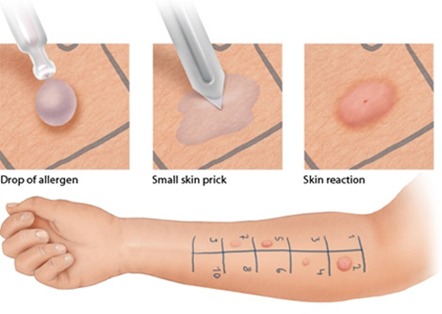
Skin Prick Test (SPT)

Under KAHER, JNMC, BELAGAVI. On behalf of all faculty members of our department Otorhinolaryngology & HNS, I Dr Vishwanath M Gowda as a co-ordinator of Rhino allergy clinic, would like to share details regarding Skin Prick Test.
Skin prick test -An accurate method to diagnose the cause of allergy
Skin prick testing (SPT) or skin allergy testing is an accurate method to identify a patient’s allergies. Let’s understand what this test involves and how it is performed.
Who requires a Skin prick test (SPT)?
Patient’s with asthma, nasal allergy or allergic rhinitis and food allergy need a Skin prick testing (SPT) to identify as to which substance their body may be allergic to (also called allergen).
What substances can be tested?
The common substance for which Skin prick test (SPT) is performed is aeroallergens. These are the allergens which are present in the environment (home, school or outside environment). The common indoor allergens are dust mites, molds, cockroaches, cat and dog dander. The most common outdoor allergens are pollen from trees, weeds and grasses.
Skin prick test (SPT) can be done for a wide range of foods such as milk, egg, soya, nuts (peanuts, cashewnut, walnut, almond, pistachio), fish and seafood.
How is Skin prick test (SPT) or skin allergy testing done?
Skin prick test (SPT) is usually performed on the forearm or sometimes the upper back. A small drop of each allergen is placed on the patient’s skin. The skin under the drop of allergen is then scratched with a lancet (as shown in the above image). This would let the allergen under the skin surface. The drop of the allergen is then wiped off. Many allergens can be tested simultaneously. The same process is repeated.
After 15 minutes of the Skin prick test (SPT), reaction is checked.
There are two types of reactions:
Positive Reaction
The skin under the drop of allergen develops an itchy raised swelling called ‘wheal’. This is surrounded by a red area called a ‘flare’. This is called the “wheal and flare” reaction. The reaction peaks at 15 to 20 minutes and then fades out. A positive reaction means that the patient is likely to be allergic to the particular allergen.
Negative Reaction
The skin under the drop of allergen does not develop a significant wheal and flare reaction. A negative reaction means that the patient is not likely to be allergic to the particular allergen.
When are the results of the Skin prick test (SPT) available?
The results of the Skin prick test (SPT) are available in 15 min.
Does the Skin Prick Test (SPT) hurt?
Skin prick tests (SPT) usually do not hurt patient since we just scratch the upper layer of skin (also called the epidermis) which does not have pain fibers. There is no bleeding since there are no blood vessels in the top layer of the skin. It might feel like a pin-prick sensation. If the Skin prick test (SPT) is positive, the reaction might feel itchy but this settles in a while.
For further queries contact –
Department of ENT & HNS, OPD NO-16
KLEs Dr. Prabhakar Kore Hospital and Medical Research Centre
Dr. Vishwanath M Gowda
Senior Resident
MBBS MS ENT
